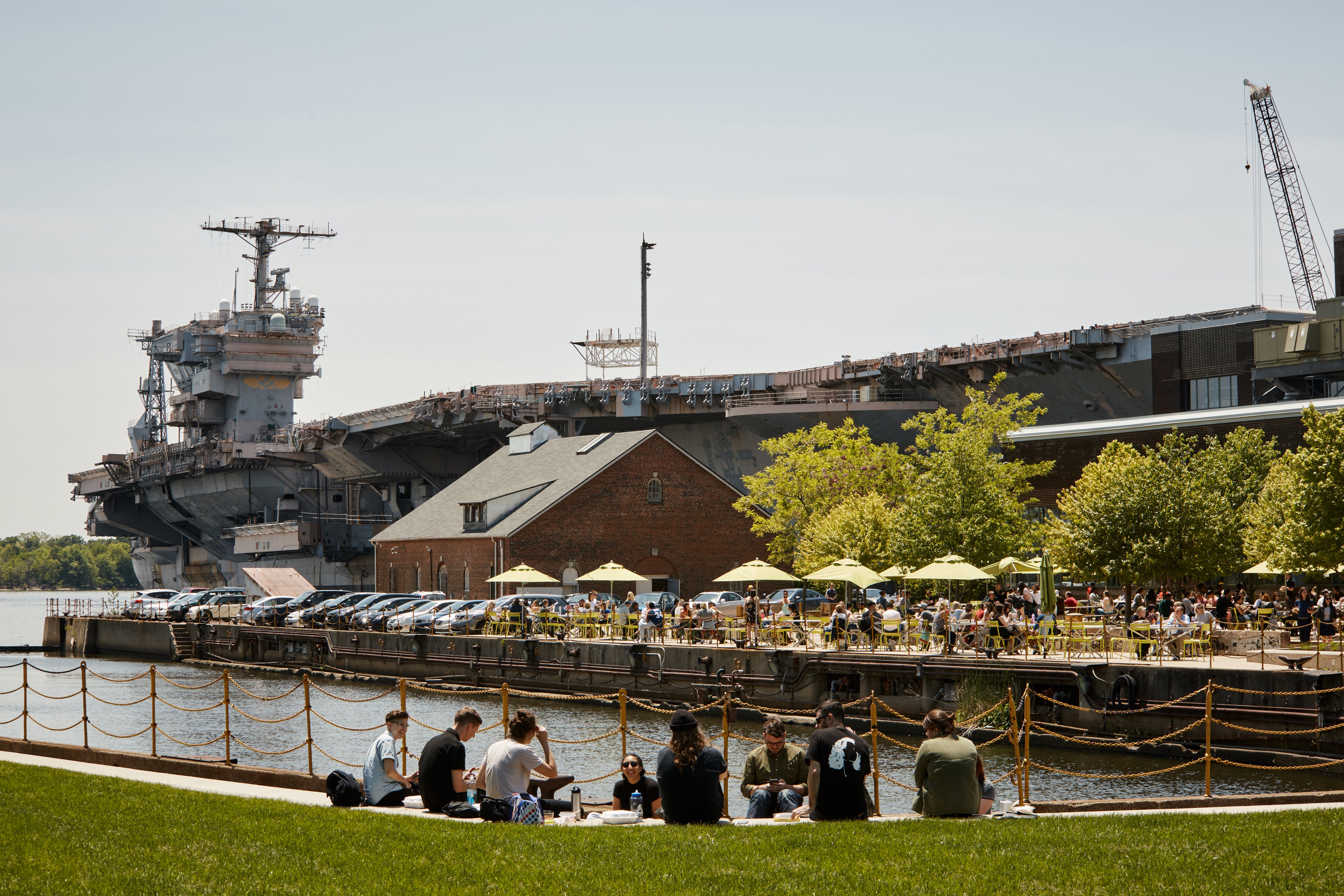Praxis Dialogues: Old buildings anchor growth at the Navy Yard

On February 28, PennPraxis and PlanPhilly will host the next Praxis Dialogues, the third in a series of public conversations about the notion of “the public good” in design practice. This time we’re focused on historic preservation and our panelists are sharing essays each week leading up to the event. So far we’ve heard from PennPraxis’ Executive Director Randy Mason on preservation and the public good, Penn Law professor and urban scholar Wendell Pritchett on preservation for a changing city. Today PIDC’s Prema Katari Gupta shares her perspective on preservation as a key ingredient for the Navy Yard’s redevelopment. By way of disclosure, Gupta serves on PlanPhilly’s advisory board.
When I was in graduate school and brand new to Philadelphia, I ran my first Broad Street Run. The road race terminates at the Marine Parade Grounds in the heart of the Philadelphia Navy Yard. Although that was well over a decade ago and I now pass through the gates of the Navy Yard daily, I vividly recall my amazement as I used what little energy I had left after the race to explore the Yard’s historic assets – its imposing battleships, Georgian Revival and Beaux Arts officers’ quarters, sturdy barrack buildings with graceful Romanesque detailing, and soaring former Naval shipbuilding structures. In fact, my first encounter with the security team, now part of my management responsibility as Senior Vice President of Navy Yard Planning & Real Estate Development, was, shall we say, brusque. (For the record, the Navy Yard is now fully open to the public and we welcome everyone, including runners, bird watchers, plane spotters, and architecture enthusiasts, to explore our campus.)
Old buildings attract people. Much has been written about the cultural, historic, and aesthetic value of older buildings, but as an economic development and real estate practitioner, I’m drawn to their intrinsic economic value.
When prospective tenants tour the Navy Yard, regardless of whether they are considering occupying a small space in one of PIDC’s historic buildings or are considering working with Liberty Property Trust on a built-to-suit office building, they are invariably drawn to the evocative qualities of the site’s rich industrial maritime past. Companies are increasingly interested in locating in places that feel less generic and more authentic. The historic environment is a recruiting tool for companies, as a younger workforce demands spaces that are unique, creative, collaborative, and have Instagram-able identity. In fact, I monitor Instagram posts geotagged at the Navy Yard in order to understand how our tenants interact and engage with our public realm; not surprisingly, posts overwhelming include historic features and structures.
Workers want to be engaged in their work and feel loyalty to the place where they work. A high quality historic workplace, with its intrinsic aesthetic and historic value, can create an extremely productive and efficient workplace. At the Navy Yard, many of the public amenities, ranging from Marc Vetri’s Lo Spiedo and URBN Shop 543, to Nava Yoga Center, are in historic buildings, so the workforce enjoys access to these places and feel connected to the broader Navy Yard campus, regardless of the vintage of their workplace.
Context matters. The Navy Yard’s master plan, developed by Robert A.M. Stern Architects in 2004 and updated in 2013, calls for millions of square feet of new construction to complement the historic building stock. Liberty Property Trust, our commercial development partner, has responded to the site’s historic context with some of the highest quality new architecture in the city, designed by Philadelphia firms such as DIGSAU and Erdy McHenry as well as international firms such as Robert A. M. Stern Architects and Bjarke Ingels Group.
Furthermore, innovation thrives in historic buildings. In The Death and Life of Great American Cities, Jane Jacobs observed that lower rent older buildings provide critical space for entrepreneurial ventures. The Navy Yard consists of a delightfully dissonant mix of old and beautifully-designed new buildings, which, in aggregate, represent a microcosm of the desirable real estate assets at different price points that have allowed the City of Philadelphia’s broader innovation economy to thrive. Jane Jacobs wrote:
As for really new ideas of any kind–no matter how ultimately profitable or otherwise successful some of them might prove to be–there is no leeway for such chancy trial, error and experimentation in the high-overhead economy of new construction. Old ideas can sometimes use new buildings. New ideas must use old buildings.
At the Navy Yard, we have seen companies graduate from a lower rent older building to innovative high-performance new office buildings in the Navy Yard’s Corporate Center. Similarly, Benjamin Franklin Technology Partners of Southeast Pennsylvania occupies Building 100 at the Navy Yard, a former marine barracks building that has been transformed into a hub for entrepreneurship, ingenuity, and business growth. PIDC, my employer and the master developer of the Navy Yard, is Philadelphia’s economic development corporation, so our inventory of historic buildings plays a critical role in our mission of supporting business growth and job creation.
Workplace trends come and go (remember when we were all supposed to be working from home in the future?) but adaptable, quality historic spaces will never go out of style. I believe that the Navy Yard will continue to thrive and fulfill its mission of promoting economic development in Philadelphia because its development will always be anchored by its varied and high quality historic building stock.
Praxis Dialogues: Preservation and the Public Good will be held at the Philadelphia History Museum on February 28 at 6:30pm. Register in advance here.
WHYY is your source for fact-based, in-depth journalism and information. As a nonprofit organization, we rely on financial support from readers like you. Please give today.




